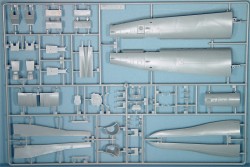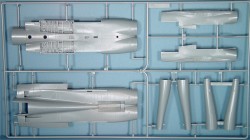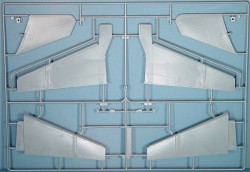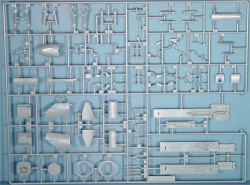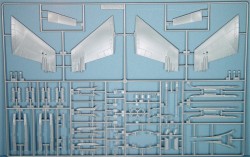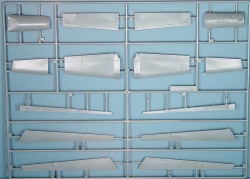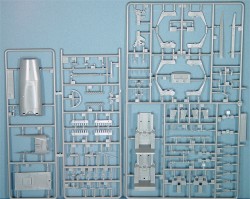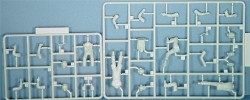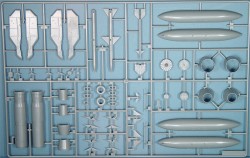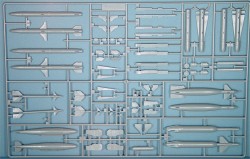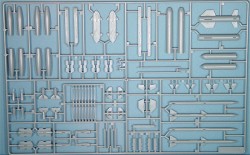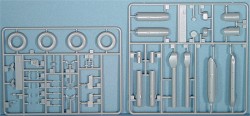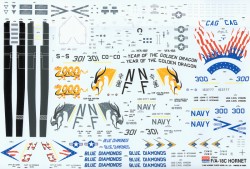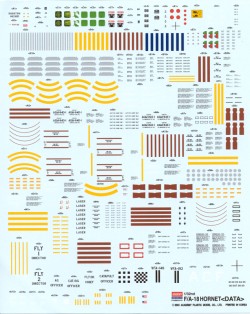SNEAK PREVIEW:
Academy's 1/32
FA-18C Hornet
|
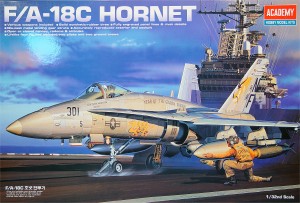 |
Background
In the early-1970s, the US Navy had started receiving deliveries of
its new superfighter, the F-14A Tomcat. The US Air Force was also receiving
deliveries of its own new superfighter, the F-15A Eagle. What was apparent
to both services was that neither could afford to equip all of its fighter
wings with these new and expensive aircraft. The Air Force addressed this
problem first with a new competition, the Lightweight Fighter (LWF). The
two major contenders were General Dynamics with the YF-16 and Northrop
with their YF-17. The Navy also expressed interest in their own lightweight
fighter and Congress gave approval with the condition that the Navy use
the same aircraft selected by the Air Force.
When the Air Force selected the F-16 for its lightweight fighter, the
Navy was not able to visualize an F-16 modified for carrier operations.
Instead, they initiated their own lightweight fighter project (VFAX) and
ultimately turned to a consortium that (leaving the turbulent contractual
history aside) led by McDonnell Douglas to adapt the Northrop YF-17 into
a carrier capable 'lightweight' fighter. The resulting design became the
F-18 Hornet (AKA 'Bug'), later redesignated as Fighter/Attack (F/A-18)
and later still simplified to FA-18. The Hornet would become the defacto
supplement to the F-14 Tomcat in the fighter world as well as the replacement
for the A-7 Corsair II light attack aircraft and (to a limited extent)
the venerable A-6 Intruder.
The FA-18 was subjected to a turbulent early life with critics citing
the Hornet’s limited range and payload as well as its costly price
tag. Nevertheless, the visionaries that stood by the Hornet would ultimately
be vindicated, as this aircraft would become the launch platform for new
generations of precision-guided weapons, eliminating the need for carriage
of larger numbers of bombs to attack the same target. In addition, the
FA-18 would also become the first Navy attack aircraft that could defend
itself in aerial combat without the need to jettison its bombs to survive
the encounter. The first true naval multirole fighter had been developed.
The Hornet has now seen combat in many parts of the world and is one
of the principal multirole combat aircraft for the US Navy, US Marine
Corps, Royal Australian Air Force, Canadian Armed Forces, and more. The
FA-18C is an evolutionary development of the Hornet, providing more modern
avionics and weapons capabilities to the fleet. Even this aircraft will
move into second echelon operations as the new 'Super Bug', the FA-18E/F
Super Hornet moves into more squadrons.
The Kit
In the world of 1/32 aircraft models, there is a hierarchy of excellence.
Years ago, Revell (USA & Germany) led the way in this scale. Hasegawa
(Japan) competed for the lead with (what was then) better technology molding
and more subjects. More recently, Tamiya (also Japanese) assumed the lead
role with their breath-taking 1/32 Phantoms and Eagles. Then along came
Trumpeter (China) with a rapid-fire array of 1/32 Fishbeds, Farmers, Frescos,
Fagots, Mongols and Warthogs. The level of detail and molding technology
in these kits raised the bar far beyond anything that has been released
in this scale from Japan. Who could possibly top this?
Leave it to the Koreans to pick up that challenge. Academy has become
famous for its phenomenal 1/35 armor kits. Starting with their Tiger tank
series, they've released a variety of self-propelled artillery pieces,
tank killers, and most recently, the M3 Stuart. With each release, there
is more and finer detail inside the vehicle and out. I wondered what would
happen if these fine armor kit craftsmen were to tackle an aviation subject?
This is exactly what happened - Academy has moved their level of modeling
excellence into their aircraft line and this Hornet is the first off that
line. Developed in conjunction with a number of experts, this kit is about
as detailed straight out of the box you can imagine. As with their armor
kits, Academy has left little room for the aftermarket detail companies
to improve what comes complete in the box.
One of the Hornet experts who supported Academy in this project is none
other than Dave Roof, who by day is the founder of Orion Model Accessories
(and an expert modeler as well) and by night tweaks one-scale Hornets
in a Marine Corps uniform (or is that the other way around?). By the time
you read this preview, Dave will have also completed his own build-up
review of this kit on Hyperscale and I will leave any issues with regards
to scale size and accuracy to the Hornet Meister. You can also see build-up
reviews on the IPMS/USA website as well.
The first thing that impressed me was the sheer size of the kit box.
At approximately 22” x 15” x 5”, it is the same length
and width as the Tamiya Eagle and Phantom kit boxes, but another inch
deeper. This will become apparent as you look over the number of parts
trees to the right. There are in fact 19 parts trees inside this box.
Sixteen of these trees are molded in medium gray styrene (three of these
trees are duplicates for extra weapons and are not illustrated); two trees
are molded in light gray styrene and four figures; and the final tree
is molded in clear styrene and contain the various lights and lenses.
In another nice touch from Academy, there is a smaller box inside the
kit that not only contains the clear parts tree, but also specially wrapped
canopy and windscreen parts, metal landing gear strut cores, radome, rubber
tires, and a bag of screws that are used sparingly to hold this project
together. All of the panel lines and appropriate details are beautifully
scribed into the model.
The project starts out with assembly of the NACES ejection seat, which
is comprised of 14 parts. Seatbelts and harnesses are molded onto the
seat cushion. The kit seat represents the SJU-5/A NACES installed in the
FA-18C and in the rear of the FA-18D. The SJU-6/A NACES is installed in
the front pit of the FA-18D and only has minimal visual differences from
the SJU-5/A. Why is this important? There are two complete seats in this
kit along with a two-pit cockpit tub, which means that there will be an
FA-18D in our future!
Speaking of the cockpit tub, the detail on the side consoles is very
nicely executed and the tub comes complete with a detailed stick, throttle
and rudder pedals. The instrument panel is another interesting work of
art. The basic part has beautiful detail molded onto its face and three
square holes for the Multi-Function Displays (MFDs). Academy has provided
an opaque part with the three MFDs that goes into the rear of the instrument
panel and three clear lenses that go into the front of the panel. If one
were to simply paint the rear opaque part dark green or black, the result
would be a beautiful rendering of the Hornet at rest. What is intriguing
is that Academy has provided three decals that go onto that rear opaque
part that, after assembly, give the appearance that the Hornet is powered
up. Very nice indeed!
The completed cockpit tub and nose gear well come together and are locked
into the forward fuselage halves. The two forward fuselage halves speak
volumes of the future of this kit. First, the assembly will support a
single or two-seat Bug with the right supplemental parts (canopy, etc.).
There is an opening on the forward left side of the kit that contains
a spot light. This kit uses a blank panel to cover this feature, as it
should with this version of the Hornet. However, there is another panel
also provided that indicates that there is a Canadian and/or Australian
Hornet in the future as well. In addition, the way that Academy has provided
the ALQ-145 ASPJ antenna covers as separate parts indicate the potential
for not only a CF-18, but also an FA-18A/B as well. The layout of this
kit is well thought out and will provide is with a wide variety of Bugs
in our future.
The radome can be posed open or closed. If you choose to position the
radome open, a detailed radar bay is provided which can be slid forward
to reveal the avionics racks. Lower nose panels are provided as separate
parts to give you your chose of early or late styled gun gas vents.
The rear fuselage is also well engineered, not only are two F404 engines
provided, Academy has also engineered the intake ducts in order for you
to peek down the intakes and see engine compressor faces. As with the
real aircraft, receiver/actuator blocks are mounted in the rear fuselage
to serve and mounts and pivots for the horizontal stabilizers.
On to the wings. The wings are molded top and bottom and with the wing
tips down and locked. However, there are cut lines molded inside the wing
halves to permit positioning the wing tips in the folded position. Two-piece
hinges are also provided to accurately pose the wing tips folded. In addition,
the wings do not have the leading edge slats nor the trailing edge flaps
and ailerons molded as part of the wing – these are provided separately.
Like the wing, the leading edge slats are provided as a single piece per
wing, but they too have a cut line molded inside to also support the folded
wing tip option. These can be positioned as desired. One truly impressive
detail in this kit is the set of aileron/flap hinges provided. Academy
has included four complete sets of hinges to pose the trailing edge flaps
and ailerons up, down a notch for maneuvering, down another notch for
take-off, and down full for landing (or at rest). Once again, check your
references to select the pose that is right for your display.
The vertical stabilizers are uniquely FA-18C/D with the antenna pod
fairings on the trailing edge of the fin tips. If/when Academy does produce
an early or international Hornet, replacement vertical stabs will be required
(or good instructions to perform the surgery to backdate the existing
tails). As with the wing lift and flight control surfaces, the rudders
are separate parts and can be positioned as desired. Likewise on the installation
of the horizontal stabilizers. Two complete sets of engine nozzles are
provided, one set with the nozzles closed down (engines shut down) and
one set dilated (engines idle).
The detail in the six-piece nose gear well is also nicely executed.
Into this well goes a very detailed nose gear strut. The core of the nose
gear is metal, providing the needed strength keep this model from later
collapsing under its own weight. Around this metal core goes another 19
parts that make up the basic strut, positionable launch bar, holdback
receiver, approach light indicator and taxi light. In addition to that,
the nose wheels are rendered in your choice of rubber or styrene, either
of which goes over a styrene wheel hub. In all, there are up to 24 parts
for just the complete nose gear assembly alone.
As with the nose gear, each main landing gear strut is comprised of
a metal core with another 15 styrene parts to represent the trailing link
gear, and shock absorber assembly. Once again, the main wheel is comprised
of a styrene wheel hub and your choice of single piece rubber tire or
two-piece styrene tire. If you were impressed with the detail in the nose
gear well (and I was), you’re going to love the main gear wells!
Rounding out the options in this kit, there is a positionable tailhook,
your choice of stowed or extended cockpit boarding ladder (and eight-part
assembly), open or closed canopy (complete with rear view mirrors), a
five-piece HUD, and your chose of open or closed dorsal speed brake.
The figures alone would make a nice kit of their own. There are four
figures provided: a seated pilot, a pilot climbing the cockpit access
ladder, a standing deck hand, and a launch director squatted into the
launch signal pose. Now if that is not enough, there are an interesting
array of heads that accompany these figures. The pilot has heads in the
following conditions:
-
No helmet or sunglasses
-
Sunglasses, no helmet
-
Helmet visor up, no O2 mask, and sunglasses on.
-
Helmet visor down, O2 mask on.
-
Helmet w/NVG goggles and O2 mask on.
Another set of parts trees that should become a separate kit for other
1/32 modern aircraft builders are six trees of external weapons options.
These include:
-
1 x AAS-38 Laser Designator pod
-
1 x ASQ-173 Laser Detector/Tracker pod
-
2 x AIM-7F/M Sparrows (the nicest I’ve seen in this scale)
-
6 x AIM-9L/M Sidewinders (w/launch rails)
-
2 x AIM-120A AMRAAMs
-
2 x AGM-84D/E Harpoon/SLAM
-
4 x AGM-65 Maverick missiles (w/launch rails)
-
4 x AGM-88 HARM w/LAU-118 launch rail adaptor
-
8 x Mk.82 500lb bombs with your chose of normal low-drag fins or
Snakeye high drag fins
-
2 x GBU-10 Paveway II Laser-Guided Bombs
-
2 x GBU-24 Paveway III Laser-Guided Bombs
-
2 x GBU-32 1000lb JDAM smart bombs (as Dave Roof pointed out, these
have Air Force fuses on them, but a few seconds with a sanding stick
will solve this)
-
2 x Twin AIM-9/AIM-120 missile rail adaptors
-
4 x Vertical Ejector Racks (VERs)
-
4 x External Fuel Tanks
The decals for this model are as stunning and complete as the rest of
the kit. Two sheets are provided, one of which is almost as big as the
box itself. On sheet one, markings are provided for four examples:
-
FA-18C BuNo 164905 VFA-192 ‘Golden Dragons’ NF/301,
USS Kitty Hawk, 2001
-
FA-18C BuNo 164905 VFA-192 ‘Golden Dragons’ NF/301,
USS Kitty Hawk, ‘Year of the Golden Dragon’ Special Scheme,
2000
-
FA-18C BuNo 163777, VFA-146 ‘Blue Diamonds’ NG/300,
CAG aircraft w/US Flag Draped Across Nose, USS Stennis, early 2000
-
FA-18C BuNo 163777, VFA-146 ‘Blue Diamonds’ NG/300,
CAG aircraft w/US Flag Draped Across Nose, USS Vinson, late 2000
The first sheet also contains a complete set of maintenance stencils
for the aircraft. The second sheet contains additional stencils for the
radar, sensor pods, weapons and MFD displays.
Conculsions
As you can see, this kit is nothing less than awesome. The folks at
Academy have now set the bar for 1/32 kits at a new all-time high and
will be very difficult for anyone to catch up to this. The Hornet is due
for release in late April/early May in the US and will easily become the
mantelpiece for Bug drivers, Bug tweakers and Bug lovers everywhere.
While not for the inexperienced modeler, this kit does not present any
unique construction challenges and will likely become a favorite of contest
tables for years to come. Stand by for a wealth of decals and other goodies
from the aftermarket community to try to jazz up an already stunning kit.
My sincere thanks to MRC for this
pre-production sample!
References
Here are some good references for your upcoming Hornet project:
-
Walk Around F/A-18 Hornet, By Greg Davis & Chris Neill, Squadron/Signal
Publications, 1999, ISBN 0-89747-401-5
-
F/A-18A/C & CF-18C Hornet, By Willy Peeters & John Brooks,
Verlinden Publications, 1992, Lock On Nr.15
-
F/A-18 Hornet in Action, By Lou Drendal, Squadron/Signal Publications,
1993, ISBN 0-89747-300-0
-
F/A-18 Hornet in Detail & Scale, by Bert Kinzey (Published under
Detail & Scale Publications, Squadron/Signal Publications &
Kalmbach Publications - check with your book seller and/or hobby shop
on this one), 1994
-
Hornet's Nest - MAG-31, by Randy Jolly, Concord Publications, 1997,
ISBN 962-361-732-1
-
World Airpower Journal, Volume 26, pp 50-111
|









|

